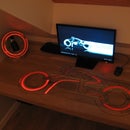Introduction: Making the Kratos' Ax Level 6 : Leviathan
After playing God of War, I thought to myself and why not do this ax myself.
After watching a lot of videos on Youtube and reading a lot of forums, I decided to get started.
By cons I want to get as close to the ax level 6 of the game and not only level 1 :)
For this project there are several phases: - welding axes - electrolysis - laying the gold leaf - realization of the handle
I have a little bit of experience on welding, but not against gold I never put gold foil, I have never done electrolysis since high school and I have never carved a handle in wood. In short, lots of things to learn!
Step 1: Weld of Ax
With Gimp I realized the 4 drawings of the cuts I had to make.
So I drew on the different axes the outline of the cuts to make. With a grinding wheel and a cutting disc, I realized the cutting of the 4 axes. I cut a 50mm metal tube to make the part that will receive the handle.
It was then necessary to weld the various parts. The grinding wheel allowed to remove the surplus of welding. Finally I used a sander to have the smoothest surface possible.
Step 2: The Test Ax
Since I had never done electrolysis I had to test on something similar.
So I made a test ax. The goal was to test the transfer of a drawing on the metal, different nail polish, electrolysis and laying of gold leaf. I learned a lot with this test and I especially preserved the real ax of my tests :).
The transfer of drawing and the laying of gold leaf did not cause me any problems during the test. On the other hand I tried crayons and the traditional polish was by far the most effective but the drawing would be more complex to draw. The various tests of electrolysis allowed me to polish the technique including putting two metals plates on each side of the ax.
Step 3: First Installation of Nail Polish
First of all it was necessary to get the ax drawing.
Then I work on it with Gimp to get the differents areas. After I printed one side of the ax at the right scale and I transferred the drawing on the ax with transfer paper. This gives a very slight mark on the faces of the ax. It only remained to iron on this light trace with a very fine brush and nail polish. I want to clarify that this task requires a lot of time and dexterity. For information it took 8 hours to have a trace nail polish :(
Step 4: First Electrolysis
The purpose of electrolysis is to attack the metal areas that are in contact with the water.
That's why I cover areas that I do not wish to electrolyze with nail polish.
It is necessary to use a DC power supply (12V / 10A in my case). It is necessary to connect the positive terminal to the metal we want to electrolyze. The negative terminal will be connected to the metal plates. The water is composed of distilled water and salt.
Attention it is something that must be done outside :)
It's a moment that I really apprehended because it could have ended badly ... But I had done several electrolysis on my test ax ... Alea jacta est! The electrolysis took more than 24 hours ... It even woke me up at night for fear of over electrolyzing the metal :( But the result was superb, the layer of nail polish worked perfectly!
NB: I think that if you use a more powerful diet it takes less time.
Step 5: Second Installation of Nail Polish
The inner runes of the ax were to be dug.
It was therefore necessary to carry out a second electrolysis. The approach is however reversed, this time we must hide everything with nail polish except the runes. For that I use a dremel to remove the varnish following the route of the runes. The advantage is that it is easier to do than the first nail polish.
Step 6: Second Electrolysis
I use the same method as the first electrolysis but by immersing only part of the ax.
I often check that the electrolysis is going well because I do not want to do stupidity ...
Step 7: The Small Piece of Metal
I cut this piece in a metal tube 50 mm in diameter.
For electrolysis, I used a curved metal plate in the shape of a circle so that it best fits the shape of the room. Electrolysis was very fast (about 15 minutes). The mass of metal being much weaker than that of the ax.
Step 8: Put Gold Leaves
This part of the project was really informative and interesting.
It was the first time I put gold leaf. Sorry for the purists, I surely had to make a lot of mistakes :)
To put a gold leaf I used a mixtion that I had to let dry 15 min. Then I put with a brush the gold leaf on this area. The pieces of gold leaf present on an unglued area can simply be removed with a brush. The part that worried me the most was the four eagles at the top of the ax. It was necessary to make the underside of the eagles ...
Step 9: Realization of the Handle
I used a chestnut branch for the ax handle.
To give it the right curves, I heated it in different places to make it easier to bend. Be careful not to overheat, otherwise the wood will be marked. Using Gimp, I transferred the patterns of the handle. I then put these patterns on the ax handle. With small wooden scissors, I dug the parts on the handle. Attention, it is necessary to use a small hammer to better master its force.
Once the parts were dug, I used the dremel to equalize the cuts. I also use the dremel to make small holes in the bottom of the excavated parts.
Once all this done, I put some "brou de noix" to dye the handle.
Then I applied gold leaf following the same principle as for the ax. First of the mixtion then I apply the gold leaf.
Finally I assembled the handle and the ax with four nails.
Step 10: Epilogue
I tested the ax on a wooden log and if everything works fine, the gold leaf does not hold.
At the same time I expected it :) It was a really long project (about 120h of work) but I really learned a lot.

Participated in the
Fandom Contest













